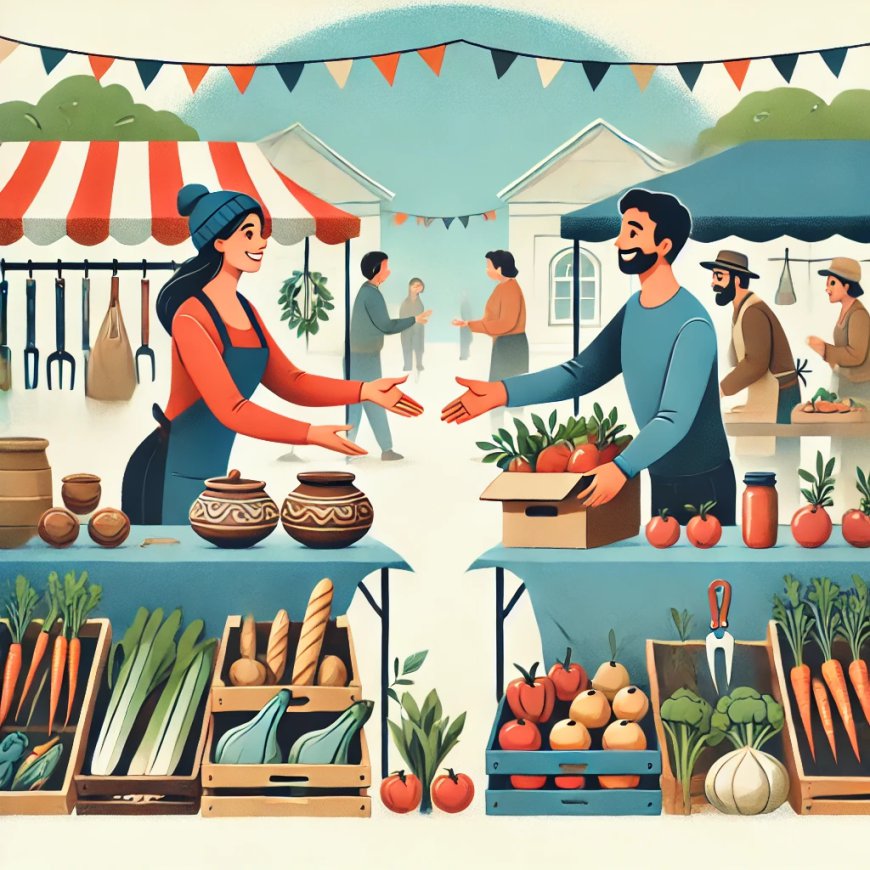How Bartering Works: The Principles Behind Trade Without Money
In this blog, we will explore the principles behind bartering, how it works, and why it remains relevant even in today's global economy.

In a world dominated by money-based transactions, bartering offers a fascinating alternative. It’s a practice as old as civilization itself, where goods or services are exchanged directly for other goods or services without using currency. In this blog, we will explore the principles behind bartering, how it works, and why it remains relevant even in today's global economy.
What Is Bartering?
Bartering is the direct exchange of goods or services between two parties without involving money. Unlike monetary transactions, where the value of an item is universally agreed upon in currency, bartering relies on the perceived value of what each person offers. For example, you might trade a book for a plant or offer a website design service in exchange for gardening help.
The Principles of Bartering
1. Mutual Agreement of Value
The core principle of bartering is mutual agreement. Each party must agree on the value of what is being exchanged. Unlike in a money-based system where prices are fixed, bartering requires both parties to negotiate until both feel they are receiving equal or comparable value.
For instance, if someone offers to trade their homemade pottery for your handmade jewelry, both of you must come to an understanding of how many pieces of pottery equate to a certain number of jewelry items.
2. Double Coincidence of Wants
One of the primary challenges in bartering is known as the "double coincidence of wants." This occurs when both parties have something the other wants. For a barter to be successful, each person must have a need or desire for the item or service the other party offers.
For example, if you’re a carpenter looking for fresh produce, you need to find a farmer who not only wants carpentry services but also has the type of produce you need.
3. Flexibility and Negotiation
Bartering thrives on flexibility. There is no fixed price, and the value is subjective, allowing for negotiation. People often adjust the quantities of their offerings to match the perceived value of the other party’s items. This flexibility is a huge advantage in barter systems as it allows customization of trade agreements based on personal needs.
Negotiation plays a critical role in bartering. Unlike cash transactions, where prices are often non-negotiable, bartering encourages discussion. Both parties must be willing to communicate clearly about their expectations and reach a consensus.
4. Fair Exchange
For bartering to be sustainable, the exchange must be perceived as fair by both parties. This concept of fairness ensures that neither party feels shortchanged or exploited. Establishing fair value requires an understanding of the quality, rarity, or labor involved in producing the goods or services.
For example, a rare book may be worth several home-cooked meals, or a day of professional photography might be traded for a few hours of home repair.
5. Building Trust and Relationships
Bartering often occurs within local communities or among individuals who know each other. Trust is essential since there’s no formal system guaranteeing the trade like in a monetary economy. Many successful barter transactions are built on trust, especially when the exchange of goods or services happens over time.
Because bartering relies on human interaction, it fosters relationships between people. Whether it’s neighbors trading gardening tools or local businesses exchanging services, barter systems promote community and social connection.
Why Bartering Works Today
While bartering may seem outdated, it still holds relevance in various aspects of modern life. Here's why:
-
Economic Crises: In times of economic uncertainty or inflation, people often turn to bartering to meet their needs without spending money.
-
Cost-Saving: Bartering is a great way to save money. Instead of spending cash, individuals and businesses can exchange what they already have or do for what they need.
-
Sustainability: Bartering promotes the reuse of goods and services, reducing waste and encouraging a circular economy. It’s an eco-friendly way of getting what you need without contributing to consumer waste.
-
Local Economies: Many local communities, farmers’ markets, and even online barter platforms enable people to exchange goods and services, keeping wealth and resources circulating within the community.
Read More :- The Ultimate Guide to Barter Exchange goods without involving money
How to Get Started with Bartering
If you're interested in bartering, here are some tips to get started:
-
Identify Your Skills or Goods: Make a list of the items or services you can offer. Whether it’s home repairs, professional skills, or unused items, knowing what you can trade is the first step.
-
Find Barter Partners: Look for local barter networks, online platforms, or community groups where people actively trade. Platforms like Craigslist, Facebook Marketplace, and dedicated bartering websites can connect you with potential barter partners.
-
Negotiate Fairly: Be open to negotiation and discuss the terms of your trade. Clearly communicate what you need and what you're offering in return to avoid misunderstandings.
-
Build Relationships: Successful bartering is often based on relationships and trust. Start within your local community, friends, or even business networks to build reliable trade partnerships.
Conclusion
Bartering is a timeless system that emphasizes the importance of mutual benefit, trust, and fairness. Whether you're exchanging services in your community or trading goods online, bartering offers an effective alternative to monetary transactions. By understanding the principles of bartering—mutual agreement, flexibility, negotiation, and fair exchange—you can successfully navigate trade without the need for money, all while building valuable relationships and promoting sustainability.
